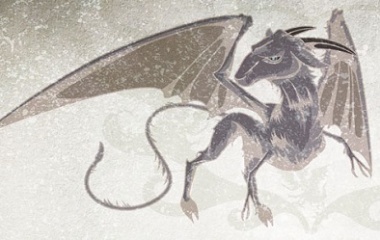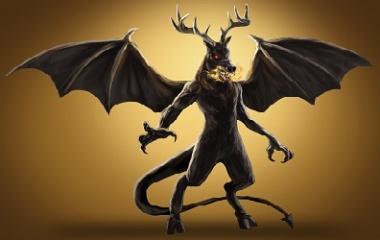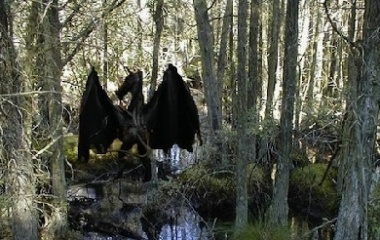What is the Jersey Devil?
The Jersey Devil (or Leeds Devil) is a flying, chimeric monster who terrorizes the people of southern New Jersey. Aside from his bizarre appearance, he is most well-known for his nasty temper and his brazen attitude towards humans.
Characteristics
Physical Description
The Jersey Devil is a patchwork of frightening traits pulled from the animal kingdom. Like many traditional “devils,” it has a goat’s head and cloven hooves. It also has leathery, bat-like wings that bring demons and gargoyles to mind. It stands like a kangaroo: supporting its weight on two legs; using its long, forked tail for balance; and keeping its short arms curled to its chest. Finally, as if this weird collection of animal parts is not unnerving enough, the creature has glowing eyes, menacing claws, and sharp teeth.
Habitat and Behavior
As the name implies, the Jersey Devil is native to New Jersey; he spends most of his time lurking in the pine barrens of the southern part of the state. This heavily forested and bog-riddled area has proved inhospitable for humans, and it has a tradition of harboring outcast characters like fugitives, moonshiners, poachers, runaway slaves, deserting soldiers, Native Americans, and even pirates. Countless ghosts are rumored to wander this gloomy landscape, so the Jersey Devil has plenty of supernatural friends for company!
The Jersey Devil is an aggressive predator. It feeds on large prey, like sheep and cattle, which it pillages from local farms. It hunts much like a hawk, circling in the sky until it spots a meal, then swooping down to catch and carry off its prey. When it is about to strike, it lets loose a cry that terrorizes any animal nearby.
As its hunting habits demonstrate, the Jersey devil is not intimidated by humans. In fact, the monster has been accused of attacking entire groups of people on multiple occasions. It has been shot with countless bullets, and even one cannonball, but it has never been injured, which might explain why it is so unafraid of humans.
Cultural Representation
Origin
According to folklore, the Jersey Devil was born to a human mother, who either had the last name Leeds or lived at Leed’s Point. Some claim that the mother was a witch, and the father was the devil himself. Others believe that the mother was an exhausted housewife who, because she already had twelve children, cried out that she wished her new baby would “go to the devil” when she found out she was pregnant. When the child was born, it appeared normal, but within moments, it transformed into a nightmare. According to some accounts, the newborn devil attacked the crowd of neighbors who had gathered to assist the mother, then flew out of the chimney and escaped. Other stories claim that the mother tried to hide the child in the attic or the basement before it broke loose and fled into the forest.
History offers a different creation story.
During colonial times, the Leeds family lived in the pine barrens of southern New Jersey. The father, Daniel Leeds, was originally part of the Quaker community, but when he began including astrological information in his famous almanacs, the Quakers were offended and tried to censor his writing. Despite this backlash, Leeds became more and more fascinated with astrology and occultism. He eventually split from the Quaker community, leaving bitter feelings on both sides.
Leeds’ popularity took another hit when he decided to align himself with crown loyalists instead of supporting the growing revolutionary movement in New Jersey. He died an infamous man, who was publicly denounced as “evil” and “monstrous.”
Daniel Leeds’ son, Titan Leeds, took over the family almanac business, but he shared his father’s controversial worldview. He even began including the Leeds family crest—which featured a winged monster, called a wyvern—in the almanacs to show his crown loyalty. It wasn’t long before he began to suffer the same personal attacks as his father. Benjamin Franklin, a competitor in the almanac business, even spread the idea that Titan was a “spirit” or a “ghost.”
With all the gossip swirling around the Leeds family, jokes about the “Leeds Devil” who lived in the pine barrens were all too common. The devil even took on the appearance of the wyvern from the Leeds’ family crest. Gradually, as generations passed, the Leeds family and their political problems were forgotten, but the devil was not. It took on a life of its own, becoming the local Bogey Monster which mothers used to threaten their children when they misbehaved.
Later, in the 1900s, newspapers and tourist attractions began referring to the Leeds Devil as the Jersey Devil, believing that the new name would get more attention.
Sightings
The Leeds Devil dwelled in the background of the pine barren’s folklore until the 19th century, when reports began rolling in that the creature had been sighted. The first documented report came from a military man, who was examining his cannons when he saw a large creature flying through the sky. The man fired on and hit the creature, but the deadly blow had no effect on it. Similarly, Joseph Bonaparte, brother of Napoleon Bonaparte, reported spotting the monster while visiting his estate in New Jersey. A number of livestock massacres were also blamed on the beast.
Around the turn of the century, a museum in Philadelphia got wind of the monster lurking in the pine barrens, and they saw a way to turn the legend into a profit. They hired taxidermists to create a model of the monster, then they charged the public to come and have a look at the “Jersey Devil,” captured at last.
But the museum’s exhibit had unexpected consequences. It unleashed a wave of mass hysteria, and in 1909, newspapers in Delaware, New Jersey, Pennsylvania, and Maryland were publishing hundreds of eye witness accounts of the devil’s mischief. There were even claims that the Jersey Devil had attacked a trolley car full of people and a bustling social club. A number of schools and factories closed because people were afraid to leave their houses. Groups of hunters scoured the mysterious forest, looking for the monster, and the Philadelphia Zoo offered a $10,000 reward for its capture.
Eventually, the hysteria quieted down, but sightings of the devil have continued to trickle in ever since.
Modern Appearances
Outside of New Jersey, the Jersey Devil’s legend is only known by avid cryptozoologists and occultists. Nevertheless, it is concerned an icon of the state, being New Jersey’s official state monster and the mascot for several sports teams. It has also found its way into a few science fiction series, including X-files.
Jersey Devil






No comments:
Post a Comment